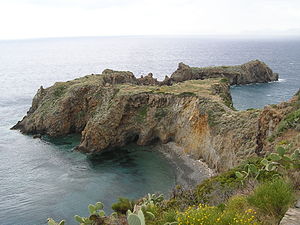Panarea
| Panarea | |
|---|---|
| View of the Capo Milazzese | |
| Waters | Mediterranean Sea |
| Archipelago | Aeolian or Aeolian Islands |
| Geographical location | 38 ° 38 '0 " N , 15 ° 4' 2" E |
| surface | 3.4 km² |
| Highest elevation | 421 m slm |
| Residents | 241 (2001) 71 inhabitants / km² |
Panarea and its neighboring islands Lipari , Stromboli , Vulcano , Salina , Filicudi and Alicudi belong to the archipelago of the Aeolian Islands , which are located in the Tyrrhenian Sea off the north coast of Sicily .
It belongs to the municipality of Lipari in the metropolitan city of Messina .
geography
Panarea has an area of 3.4 km² and a population of 241 (as of the 2001 census). It is the smallest and oldest volcanic formation in the archipelago.
Together with the neighboring, uninhabited island of Basiluzzo and the cliffs of Spinazzola, Lisca Nera, Lisca Bianca, Dattilo and Bottaro off the east coast, Panarea forms its own small archipelago with a common volcanic origin.
The highest point of the island is the Punta del Corvo in the north-western part with a height of 421 m. Capo Milazzese is located in the southeast of the island.
The three villages of San Pietro, Ditella and Drauto, whose borders are now blending into one another, are located on the east coast. Ferries and hydrofoils run from the port in San Pietro to Messina , Milazzo and the other Aeolian Islands.
history
Finds show that Panarea was already inhabited during the Bronze Age. The remains of a Middle Bronze Age settlement on Cape Punta Milazzese , which can be ascribed to the Milazzese culture (approx. 1430–1270 BC) named after this site, are particularly significant . This culture shows a very strong relationship to the Thapsos culture of Sicily at about the same time . The settlement was located on the steep cliffs of the cape, very well protected, and was only accessible via the narrow isthmus that connects the cape with the rest of the island. The settlement apparently only existed for a relatively short time. Imported Mycenaean ceramics from Greece can - as far as can be determined - exclusively date to the Late Helladic III A1 phase , which would mean that the settlement was towards the end of the 15th century or the early 14th century BC. Was inhabited. Many vessels and other objects found in situ in the buildings indicate a very sudden end to the settlement.
In ancient times the island was called Eunonymus (island of good omens) due to the rich fauna and flora .
In the 16th century the corsair Turgut Reis (also called Dragut) sought refuge on the east coast of Panarea several times. The place name Drauto is traced back to it.
tourism
Tourism is the main livelihood of the islanders. In addition to day tourists during the summer months, Panarea is a summer meeting place for wealthy Italians. The most beautiful beach is located in the southeast at Cala di Junco. Other bathing opportunities on sand and pebble beaches are sometimes only accessible from the water.
The excavations of a Bronze Age village on Capo Milazzese are culturally worth seeing. The settlement comprised about 50 round buildings and one rectangular building, which probably served as a meeting room. The foundation walls of 23 round buildings as well as millstones, cookware and ceramic vases have been preserved.
On the Isola di Basiluzzo, which was a popular summer retreat for the Romans in ancient times, there are remains of a Roman villa, floor mosaics and wall paintings. The remains of a landing stage and a thermal bath lie three meters below the water level.
literature
- Eva Gründel, Heinz Tomek: Lipari Islands . DuMont Reiseverlag, Cologne 2003, ISBN 3-7701-6028-2 .
- Reinhard Jung: ΧΡΟΝΟΛΟΓΙΑ COMPARATA. Comparative chronology of southern Greece and southern Italy from approx. 1700/1600 to 1000 BCE. Verlag der Österreichische Akademie der Wissenschaften, Vienna 2006, pp. 83–86 (on the Bronze Age settlement).
Web links
- Panarea in the Global Volcanism Program of the Smithsonian Institution (English)
- Panarea website
- Information on the Bronze Age settlement of Punta Milazzese (not up to date on all points)
Individual evidence
- ↑ Information from ISTAT.it
- ↑ Reinhard Jung: ΧΡΟΝΟΛΟΓΙΑ COMPARATA. Comparative chronology of southern Greece and southern Italy from approx. 1700/1600 to 1000 BCE Vienna 2006, p. 86; Discussion of the individual fragments pp. 84–86.




